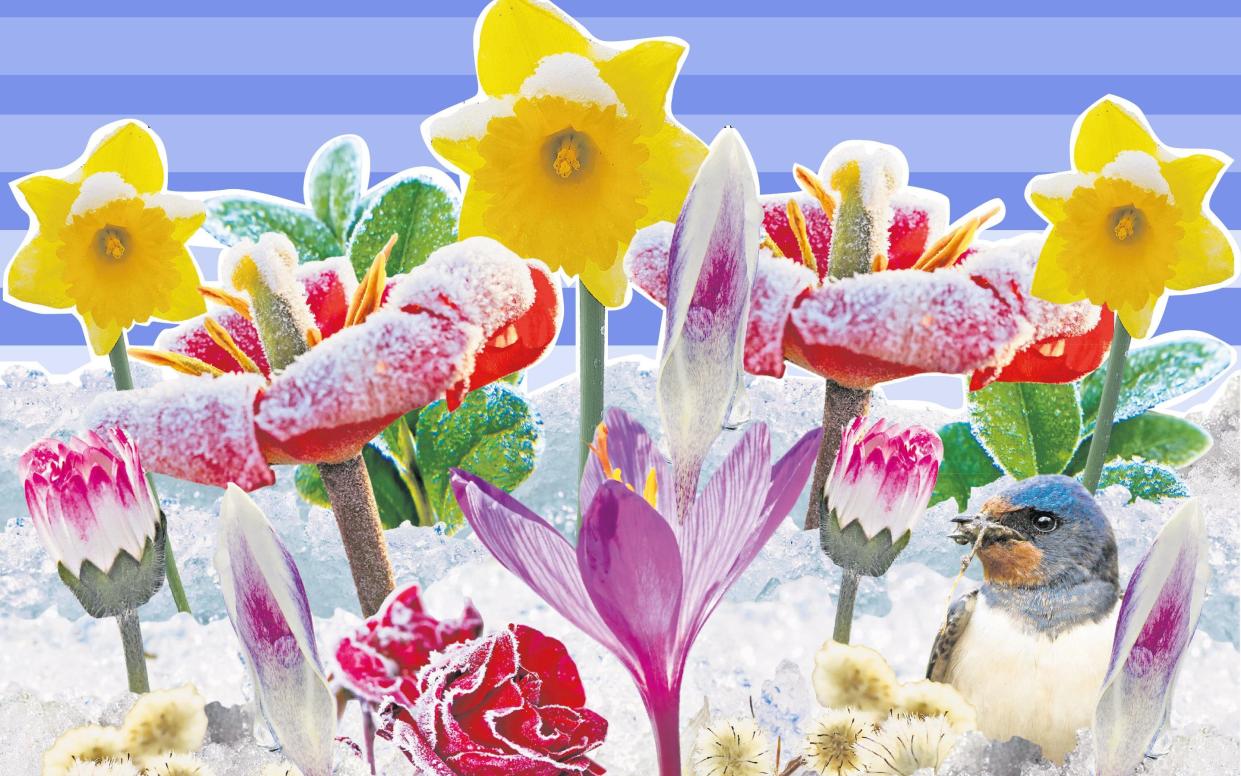Flaming April... then frosts: Are you ready for the Backward Spring?

- Oops!Something went wrong.Please try again later.
- Oops!Something went wrong.Please try again later.
In April 1917, Thomas Hardy published a poem entitled A Backward Spring. The weather was particularly foul across much of Europe that year. At dawn on Easter Monday, British troops began the offensive that would become known as the Battle of Arras, sloshing through no-man’s land in heavy sleet and snow. “It was not the weather for the attack we had hoped for,” is how one report of the day witheringly encapsulated the conditions.
Hardy’s poem focused on the weather back on the home front. Temperatures were so low that, during April, he noted, the “trees were afraid to put forth buds, and there was timidity in the grass”. The myrtle bush, meanwhile, “asks if it’s worth the fight this year with frost and rime, to venture forth one more time”.
Over the course of the past week or so, many of us have felt that we are similarly enduring a backward spring. It has officially been the coldest start to April for eight years. Temperature readings for the first week of the month show an average high of 10.4C and an average low of 2C at southern weather stations. Earlier this week, a low of -4.1C was recorded at Winchcombe Sudeley Castle in Gloucestershire.
The mini-heatwave of last week now feels a distant dream. The magnolia trees that previously filled your social media feeds have had their flowers nipped off and browned by successive hard frosts. Parts of the country have seen more than four inches of snow over recent days, with blizzards from London to Sheffield and beyond.
And for all those looking forward to their first pub garden pint on Monday April 12, I’m afraid the long-term outlook for our new alfresco lives is what the forecasters might optimistically call “bracing”. While the sun will shine in places, there is plenty of unsettled weather ahead, with temperatures struggling below average. The cold and winter-like conditions will particularly affect northern areas until at least April 19, the Met Office has said, as “notable” overnight frosts continue to develop.
Oh, for the glorious April of last year, when average daily temperatures of 16C were recorded in the first week. That spring, we marvelled at the jubilant birdsong rising with the sap. Now, the poor things shiver on the bare branches, waiting for the whole business of spring to commence.
A surefire sign of a prolonged cold snap at this time of year is when nightly candles, known as boujies, are lit in French vineyards to protect them from the frosts. Winemakers are particularly susceptible to spring frosts. Even last year, during what was the sunniest spring on record, a successive run of three days of hard frost damaged more than 180 British vineyards between North Yorkshire and Cornwall.
One vineyard, Breaky Bottom in Sussex, suffered significant damage to its vines for the first time since 1974. Kieron Atkinson, who runs a vineyard at Renishaw Hall in Derbyshire, was also badly affected, losing 80-90 per cent of his crop at a cost of about £16,000 worth of fruit.
He attempted to light boujies as frost protection, although such was the number required, it soon proved unsustainable. This year, he hopes, the worst of the frosts will have passed this week before his vines have started to produce new shoots, which is when they are most vulnerable. Although, that said, he admits he is waking up every morning on tenterhooks.
“For me, this is the scariest time of year,” he says. “Once you have got past the opportunity to damage buds, then at least you know you are going to have a crop.”
As much as it threatens livelihoods and dampens our own spirits, a freezing start to spring can cause haywire in the natural world. Near the headquarters of the British Trust for Ornithology (BTO) in Thetford, Norfolk, there has been an early influx of summer migrants tempted to cross over into Britain by warmer temperatures last month.
Paul Stancliffe, who has worked for the trust since 2006, has counted around 25 sand martins and 30 swallows, early arrivals after migrating from sub-Saharan Africa. The temperatures have been so low, he says, that the birds are now struggling to find insects to eat and have been reduced to hawking low over watercourses for aquatic species.

Normally, he says, summer migrant birds can survive about four days in thick snow. When temperatures hover around freezing, they can last around a week.
The general trend over recent decades is for spring to arrive ever earlier each year. Scientists can chart the progress of spring through monitoring the emergence of flora and fauna and records show that, between 1891 and 1947, the season moved up the country in a north-easterly direction at around 1.2mph, meaning that it travelled around 28 miles per day. But these days, due to climate change, the season speeds up Britain at 1.9mph, covering a distance of 45 miles each day.
Even with this general trend, there is still room for a lot of flexibility on any given year. The last time spring temperatures were this low, in 2013, the BTO conducted an experiment investigating the impact of the cold on bird-nesting times. It found species such as blue tit and chaffinch laid their eggs nearly two weeks behind schedule, while the average laying date for the song thrush and blackbird was the latest on record. The timings were more in line with dates recorded in the 1960s, before the impact of climate change had started to be properly felt.
Dr Erica McAlister is an entomologist and senior curator at the Natural History Museum and author of The Secret Life of Flies. Generally speaking, she says, many insect species will hunker down when temperatures dip below 10C and wait until a spell of warm weather. Some insects will enter into what she describes as a “chill coma” – a mini period of dormancy to shut down body processes and save energy to keep warm.
She insists she is not overly worried about the prolonged impact of the cold spring, pointing out that house flies have been found to survive at Everest base camp.
“As long as it’s not an extended period of this cold weather, it shouldn’t truly have an impact on insect populations,” she says. “A lot of insects time their emergence for warm weather periods. They have spent a long time evolving an understanding to figure out what is going on.”
At the Royal Horticultural Society gardens in Wisley, Surrey, chief horticulturalist Guy Barter has witnessed similar flexibility among the plants. He says the magnolia and camellias have borne the brunt of the recent cold blast – although planting the former in woodland helps preserve its flowers from frosts.
But many native trees and shrubs are simply sitting it out until things warm up. Paradoxically, he says, this could lead to us eventually enjoying spring for longer. “If it’s cold, our native species go into suspended animation and carry on when the weather picks up,” he says. “Standing in Wisley at the moment, all the lovely daffodils will last much longer than they would [if the weather had been warmer].”
He insists he has enjoyed the horticultural challenge of preserving his more vulnerable plants during the recent frosts. But all the same like many of us he admits there have been periods over the past week when the continual chill has dampened his spirits.
In those moments of weakness, he admits, he thinks: “Oh God, please roll on May.” That is a sentiment many of us shivering through this spring can share.
Joe Shute’s latest book, Forecast: A Diary of the Lost Seasons, will be published in June. To pre-order your copy, call 0844 851 1514 or visit the Telegraph Bookshop.
Your seven-day weather forecast
Things remain cold into the weekend with a band of rain edging into southern areas. Expect wintry showers in Scotland and coastal areas. The weekend should bring more widespread frosts with overnight temperatures well below freezing in many areas.
The early part of next week things warm up slightly although temperatures remain below average. A mixture of sunny spells and showers are forecast across most of the country over the following days with prolonged rain and stronger winds in the west and north west.
Looking further ahead, similarly unsettled conditions and lower than average temperatures are expected for much of the rest of the month, but there is an increased chance of warmer spells in early May.
The best things to buy this spring

Top from L to R: Freja recycled cotton throw, £20, Beaumonde; Arctic Leopard hot water bottle, £54, Helen Moore; Firebowl with log store, £309, Firepits UK; Pisa indoor/outdoor egg chair, £495, Ella James

